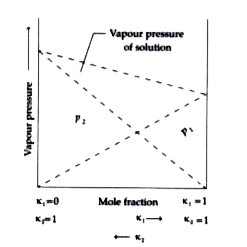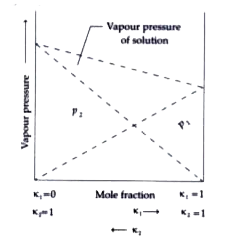Assertion (A): Henry's law and Raoult's law are not independent, i.e., one can be derived from the other.
Reason (R ): The partial pressure is directly proportional to the mole fraction of the concerned species for ideal solutions.
If both (A) and (R) are correct and (R) is the correct explanation for (A)
If both (A) and (R) are correct but (R) is not correct explanation for (A)
If (A) is correct but (R) is incorrect
If (A) is incorrect but (R) is correct
The correct Answer is:B
Step by step video, text & image solution for Assertion (A): Henry's law and Raoult's law are not independent, i.e., one can be derived from the other. Reason (R ): The partial pressure is directly proportional to the mole fraction of the concerned species for ideal solutions. by Chemistry experts to help you in doubts & scoring excellent marks in Class 11 exams.
Updated on:21/07/2023Topper's Solved these Questions
- SOLUTIONS (GENERAL AND COLLIGATIVE PROPERTIES)Book:OP TANDONChapter:SOLUTIONS (GENERAL AND COLLIGATIVE PROPERTIES)Exercise:Matrix
Explore 9 Videos
- SOLUTIONS (GENERAL AND COLLIGATIVE PROPERTIES)Book:OP TANDONChapter:SOLUTIONS (GENERAL AND COLLIGATIVE PROPERTIES)Exercise:Integer
Explore 9 Videos
- SOLUTIONS (GENERAL AND COLLIGATIVE PROPERTIES)Book:OP TANDONChapter:SOLUTIONS (GENERAL AND COLLIGATIVE PROPERTIES)Exercise:Level-B
Explore 53 Videos
- PROBLEMS BASED UPON STRUCTURES AND REACTIONS OF ORGANIC COMPOUNDS Book:OP TANDONChapter:PROBLEMS BASED UPON STRUCTURES AND REACTIONS OF ORGANIC COMPOUNDS Exercise:Some Solved Problems
Explore 21 Videos
- STATES OF MATTER (GASES AND LIQUIDS)Book:OP TANDONChapter:STATES OF MATTER (GASES AND LIQUIDS)Exercise:Self Assess,ent
Explore 28 Videos
Similar Questions
Assertion (R): At low concentration equimolar solutions of non electrolytes are isotonic and have equal osmotic pressure.
Reason (R): Osmotic pressure is directly proportional to temperature of solution.
View SolutionIdentify the law which is stated as:
For any solution, the partial vapour pressure of each volatile component in the solution is directly proportional to its mole fraction.
View Solution
Knowledge Check
STATEMENT-1 : Henry's law and Raoult's law are not independent, i.e., one can be derived from the other
and
STATEMENT-2 : The partial pressure is directly proportional to the mole fraction of concerned species for ideal solutions.AStatement-1 is True, Statement-2 is True, Statement-2 is a correct explanation for Statement-10BStatement-1 is True, Statement-2 is True, Statement-2 is NOT a correct explanation for Statement-10CStatement-1 is True, Statement-2 is FalseDStatement-1 is False, Statement-2 is TruePartial pressure of a solution component is directly proportional to its mole fraction. This is known as
AHenry's lawBRaoult's lawCDistribution lawDOstwald's dilution lawPartial pressure of a solution component is directly proportional to its mole fraction. This statement is known as
AHenry's lawBRaoult's lawCDistribution lawDOstwald's dilution law
Assertion (A) : The vapour phase is always richer in the component which is less volatile.
Reason (R) : The relative lowering of the vapour pressure of a solution is proportional to mole fraction of the solvent.
View SolutionIf Raoult's law is obeyed, the vapour pressure of the solvent in a solution is directly proportional to
View SolutionAssertion: Column's law can be derived from Gauss's law.
Reason: Gauss's law can be derived from Coulombs law.
View SolutionRead the passage given below and answer the following questions :
Raoult's law states that for a solution of volatile liquids, the partial vapour pressure of each component of the solution is directly proportional to its mole fraction present in solution. Dalton's law of partial pressure states that the total pressure Ptotal over the solution phase in the container will be the sum of the partial pressures of the components of the solution and is given as:
Ptotal= P1+ P2

What type of deviation from Raoult's law does the above graph represent ?
View SolutionRead the passage given below and answer the following questions :
Raoult's law states that for a solution of volatile liquids, the partial vapour pressure of each component of the solution is directly proportional to its mole fraction present in solution. Dalton's law of partial pressure states that the total pressure Ptotal over the solution phase in the container will be the sum of the partial pressures of the components of the solution and is given as:
Ptotal= P1+ P2

Which of the following aqueous solutions should have the highest boiling point ?
View Solution